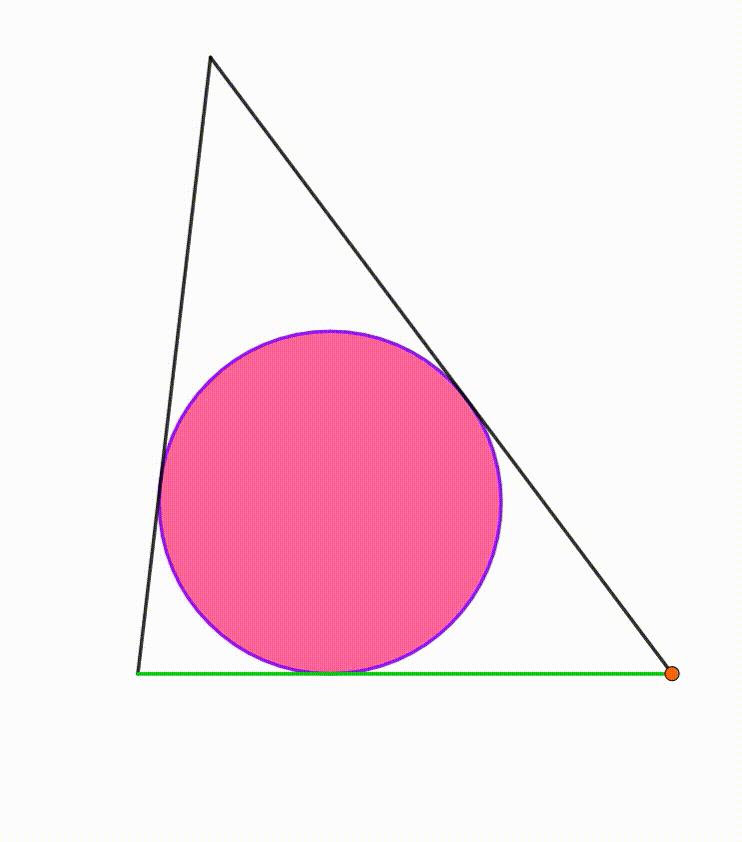Dynamic Geometry: P53
 The diagram shows a primitive
Heronian triangle
triangle with altitudes
,
,
with its incircle (purple). An orange point is traveling freely along the longest side. This point allows us to draw a cevian (green) dividing the triangle into two smaller triangles. We draw their respective incircles. When the radii of the
circles are in arithmetic progression, the ratio of the radius of the larger incircle to the radius of the smaller incircle can be expressed as:
The diagram shows a primitive
Heronian triangle
triangle with altitudes
,
,
with its incircle (purple). An orange point is traveling freely along the longest side. This point allows us to draw a cevian (green) dividing the triangle into two smaller triangles. We draw their respective incircles. When the radii of the
circles are in arithmetic progression, the ratio of the radius of the larger incircle to the radius of the smaller incircle can be expressed as:
where , and are positive integers. is square-free. and are coprime. Find .
Note : the smallest circle shall be the one tangent to the longest side and to the shortest side.
The answer is 82.
This section requires Javascript.
You are seeing this because something didn't load right. We suggest you, (a) try
refreshing the page, (b) enabling javascript if it is disabled on your browser and,
finally, (c)
loading the
non-javascript version of this page
. We're sorry about the hassle.
Label the Heronian triangle A B C with side lengths a , b , and c ; and the moving point P . From the given altitudes we have 2 0 a = 5 1 4 4 c = 2 9 7 2 0 b = Δ , where Δ is the area of △ A B C . Since a Heronian triangle has integer side lengths and area, we can assume b = 2 9 , then Δ = 7 2 0 , a = 3 6 , and c = 2 5 .
Using sine rule and cosine rule we can find the measures of angles A , B , and C and using the formula tan 2 θ = sin θ 1 − cos θ , we can find all the tangents of half-angles of A , B , and C .
⎩ ⎪ ⎨ ⎪ ⎧ tan A = 1 7 1 4 4 tan B = 8 7 1 1 6 tan C = 2 1 2 0 ⟹ tan 2 A = 9 8 ⟹ tan 2 B = 2 1 ⟹ tan 2 C = 5 2
Let the radius of the incircle of △ A B C be r 0 . Then we have:
r 0 cot 2 A + r 0 cot 2 B ( 8 9 + 2 ) r 0 = 2 5 ⟹ r 0 = 2 5 = 8
Similarly, let the radii of the cyan and pink circles be r 1 and r 2 respectively, ∠ P A B = θ , and t = tan 2 θ . Using half-angle tangent substitution , we have:
r 1 cot 2 θ + r 1 cot 2 B t r 1 + 2 r 1 ⟹ r 1 = 2 5 = 2 5 = t 1 + 2 2 5 = 2 t + 1 2 5 t
r 2 cot ( 2 A − 2 θ ) + r 2 cot 2 C 9 8 − t 1 + 9 8 t r 2 + 2 5 r 2 2 ( 8 − 9 t ) 5 8 − 2 9 t ⟹ r 2 = 2 9 = 2 9 = 2 9 = 2 − t 2 ( 8 − 9 t )
Now r 1 , r 2 , and r 3 are in a arithmetic progression, we have:
r 1 + r 0 2 t + 1 2 5 t + 8 2 t + 1 4 1 t + 8 4 1 t 2 − 7 4 t − 1 6 3 1 t 2 + 4 6 t − 1 6 ⟹ t = 2 r 2 = 2 − t 4 ( 8 − 9 t ) = t − 2 4 ( 9 t − 8 ) = 7 2 t 2 − 2 8 t − 3 2 = 0 = 3 1 5 4 1 − 2 3 Since 2 θ < 9 0 ∘
Then the ratio of radii:
r 1 r 2 = 2 r 1 r 1 + 8 = 2 1 + r 1 4 = 2 1 + 2 5 t 4 ( 2 t + 1 ) = 2 1 + 2 5 8 + 2 5 t 4 = 5 0 4 1 + 2 5 ( 5 4 1 − 2 3 ) 1 2 4 = 5 0 4 1 + 2 5 ⋅ 4 9 6 1 2 4 ( 5 4 1 + 2 3 ) = 5 0 4 1 + 1 0 0 5 4 1 + 2 3 = 1 0 0 5 4 1 + 1 0 5 = 2 0 4 1 + 2 1 Note that r 1 + 8 = 2 r 2
Therefore l + m + n = 4 1 + 2 0 + 2 1 = 8 2 .